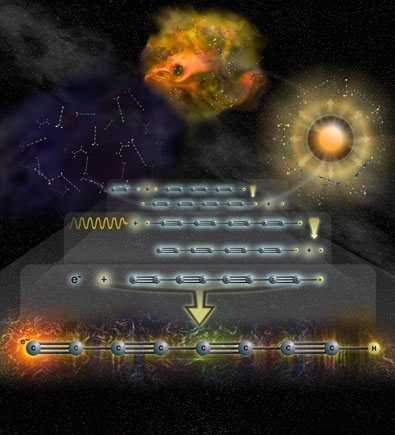Astrochemists who waited 25 years to find an anion in space have spotted three in less than a year. The latest detection, the octatetraynyl ion (C8H-), is the largest negatively charged molecule ever seen in space, beating C4H- and C6H-, discovered late last year. The recent anion bonanza forces a rethink in models of interstellar chemistry, say astronomers.
US teams at the National Radio Astronomy Observatory (NRAO), Virginia, and the Harvard Smithsonian Centre for Astrophysics, Massachusetts, detected the octatetraynyl ion in a cold, dark gas cloud in the constellation Taurus, and also in the envelope of gas surrounding a dying giant star in the constellation Leo. The scientists matched radiowave signals collected by the Green Bank Telescope in West Virginia to laboratory measurements of the C8H- spectrum.
Around 150 molecules have so far been identified in the interstellar gas clouds from which comets, stars and planets eventually form. A dozen are cations, formed when UV radiation strips away an electron. As far back as 1981, Eric Herbst suggested that negative molecular ions might be found in gas clouds, but astronomers had doubted that molecules could hold onto extra electrons long enough to be spotted. 'That's obviously not the case,' said Mike McCarthy of the Harvard team. 'Anions are surprisingly abundant.'
Sandra Brünken, also of the Harvard team, estimates that each octatetraynyl ion would survive about two months in space before being destroyed by reactions with cations.

Space monster: the octatetraynyl ion (C8H-), is the largest negatively charged molecule ever seen in space
© NRAO/ApJ
|
Astrochemists are keen to find more molecular anions, said Anthony Remijan of the NRAO. They are determining the laboratory spectra of CN-, OH-, CH2CN-, C2H- and C10H-, in the hope of spotting any of them in space. But though these and many other anions may be out there, finding them will be tough. The spectra they emit are very weak, hard to extract from a jumble of radiowave signals. Linear chain anions are the easiest to spot, said Remijan, 'but to find C10H-, the next largest in the chain, would take more than 1000 hours on the Green Bank Telescope. So unless we find another richer source of molecular anions [apart from the gas clouds already identified], the hopes of finding C10H- are very slim.' Still, with laboratory spectra in place, at least the scientists know what to look for.
Such bounty hunting brings rich rewards. The large anions already found show that chemical reactions in space are more complicated than theorists had assumed. 'Our chemical models assume hundreds of undetected reactive species, including small anions, but none as big as these,' said astrochemist Andrew Marckwick-Kemper, of the University of Manchester, UK. In turn, this means more potential routes to the complex organic molecules which, via comets and meteorites, may have seeded life on the early Earth.
Richard Van Noorden




